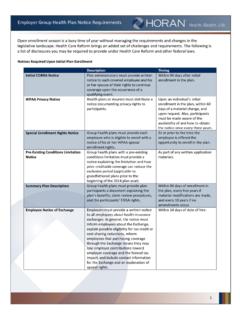Transcription of Form 5500 and Summary Annual Report (SAR) - …
1 Form 5500 and Summary Annual Report (SAR) Title I and Title IV of the Employee Retirement Income Security Act (ERISA) of 1974 and the Internal Revenue Code (IRC) require plan sponsors to file Form 5500 for certain employee benefit plans. The Form 5500 is reported to the Employee Benefits Security Administration (EBSA) on an Annual basis and must be filed electronically. The filing is informational only and provides financial and operational information for each welfare benefit plan. Welfare benefit plans include health, dental, life, vision, disability, accident and death as well as other plans.
2 Employers also have Form 5500 filing requirements for their retirement plans. Requirements for retirement plans are specific to those plans and are not discussed in this article. Most welfare benefit plans with 100 or more participants at the beginning of the plan year are required to file Form 5500 . The number of plan participants includes enrolled employees and former employees with continuation of benefits, but does not include dependents. Plans with less than 100 participants at the beginning of the year are generally exempt from filing Form 5500 unless they are considered funded.
3 Plans are considered funded when benefits are paid from plan assets in whole or in part rather than general employer assets. Employee contributions unless accepted through a cafeteria plan are generally considered plan assets. Some plans and entities are exempt from filing. These exclusions can include unfunded plans that cover less than 100 participants, church and government plans. Multiple Employer Welfare Arrangements (MEWAs) are never exempt from filing. The 5500 filing includes the main body of the 5500 filing and related schedules. The main body of the filing contains information about the plan, plan sponsor, participants and benefits provided.
4 Attached schedules contain information about plan funding, benefits paid, premiums, commissions and fees paid by the plan. Filing is due no later than the last day of the seventh month following the end of the plan year. Plans with an ERISA plan year ending on December 31 need to file Form 5500 no later than July 31. A 2 month extension can be filed through Form 5558. This extends the deadline for calendar year plans to October 15. Plan administrators failing to comply with filing requirements could face large penalties. Fines can be up to $1,100 per plan for each day the plan administrator fails to file a complete Report .
5 The Department of Labor (DOL) does provide a program to encourage voluntary compliance with the Annual reporting requirements. The Delinquent Filer Voluntary Compliance Program (DFVCP) provides an option to avoid certain penalties by satisfying requirements on a voluntary basis. The DFVCP is not available if the DOL finds the error prior to the plan administrator filing for the DFVCP. Once the Form 5500 is filed plan administrators also need to provide a Summary of information to participants and beneficiaries of the plan. This Summary is known as the Summary Annual Report (SAR).
6 The SAR must be provided within nine months from the close of the plan year (no later than September 30 for calendar year plans); plus a two month extension if an extension was filed. The SAR should be distributed to all participants of the plan during the year for which the plan information is being reported. Distribution can be paper or electronic, but must meet the DOL distribution requirements. The DOL requires that notices be provided in a manner reasonably calculated to ensure actual receipt of the material by the participant. These methods include: Hand-delivered to employees at their worksite (merely posting material is not acceptable).
7 Form 5500 and Summary Annual Report (SAR) mail via first, second or third class only if return and forwarding postage is guaranteed and address correction is requested. Electronic media (in accordance with electronic distribution guidelines). Electronic distribution of notices to active employees requires that employees have work-related computer access at any location where the employee performs his or her duties and that they have access to the employer s electronic information system as an integral part of those duties (merely providing a computer in a common area does not satisfy this requirement).
8 The electronic transmittal must contain a statement that the employee may request a paper copy. Notification can be distributed electronically to employees without work-related access, former employees, spouses or dependents if the individuals give written consent to receive notices in electronic format. Prior to consenting to receive electronic distribution of notices, an individual must be given a statement that clearly explains the types of documents to which the consent applies (that consent can be withdrawn at any time), the procedures for withdrawing consent and updating the address used for receipt of such documents, the right to request and obtain paper versions free of charge and hardware or software needed to access and retain electronically distributed documents.
9 The information contained herein is informational only and not intended as, nor should be construed as, legal or accounting advice. Neither HORAN nor its consultants provide legal, tax, nor accounting advice of any kind. We make no legal representation nor do we take legal responsibility of any kind regarding regulatory compliance. Please consult your counsel for a definitive interpretation of current statute and regulation and their impact on you and your organization.
